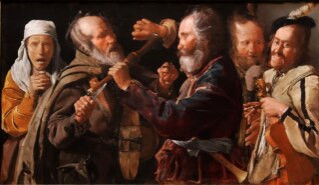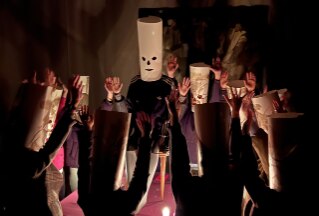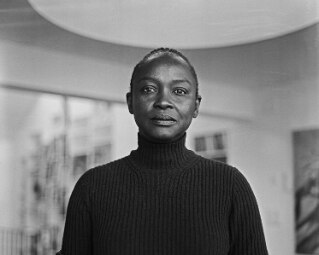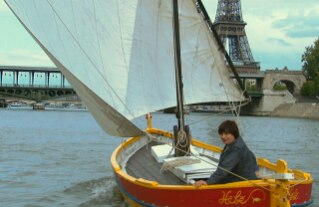Croatian artist David Maljkovic's Scene for a New Heritage video trilogy deals with this kind of "collective amnesia": the replacement of lost utopias with new ones, the building of a future out of the present alone. Each of the videos was shot in and around the Petrova Gora spomenik, envisioning three separate moments in the future and as many roles for the abandoned monument. In 2045 a group of young men arrive on a couple of tinfoil-wrapped cars, singing in a futuristic idiom that is really an ancient Croatian folk language, Ganga. They are discussing the building and what's to be done with it, wondering how can it be changed into something new. Eventually they leave, and the second video is a more contemplative exploration of the monument's inner space, as the snowy winter surrounds it, further isolating it from space and memory. Finally, in the third video, the ideological space of the spomenik is reclaimed by little crowds of people that casually hang out around it, turning it into a public area for informal socialization. Amnesia accomplished.

Modernism infuses the rest of the artist's work in other ways, starting from the omnipresent tripod, always providing a point of view and a focal center in the exhibition space. This element is featured in both Maljkovic's installations and photos, pointing the visitor's gaze in a given direction — the picture of an housing block, a blinding light, a wall. Another component of the artist's imagery is the tinfoil, sometimes present as an oilcloth or a painted surface, maybe a silvery reminder of a poor man's science fiction, the building tool for any low-tech utopia.
Maljkovic's collages involve architectural sketches, historical black and white photos and, sometimes, canvases that appear almost completely white — exception made for a few colorful pixel-like additions. Despite using minimal aesthetics, though, the artist also indulges in spomenik-like imagery and builds geometrical wooden structures around some of his video installations, enclosing the screenings into an architectural frame reminiscent of a camera's shutter.

There is a definite gap between Maljkovic's spatial installations and his sci-fi-infused videos and collages, but the common denominator is his concern with framing. The artist's close involvement with the presentation of his own shows is a prime example of this, but of course here "frame" goes far beyond a canvas' boundaries. In the Recalling Frames series the artist reflects on historical and cinematic frames, in his installations sometimes a frame is an empty reliquary. As another example, during my visit of the museum I mistook a screened up window as one of Maljkovic's artworks.
By bridging the Croatian artist's own poetic evolution and the museum's focus on art historiography, "Sources in the Air" is an important show











